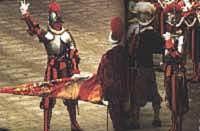Papal States
Surrounding the Eternal City, Rome, lies the Patrimony of St. Peter, commonly known as the Papal States. It is a somewhat reduced temporal territory administered by the Latin-Rite Roman Catholic Church. Since the Vatican Council, the Pope has entrusted the day to day running of the States to the Roman Senate; concentrating instead on the many issues that face the Church in the 21st century.
Rulers
The Patrimony is ruled by the Popes of Rome, in their capacity of temporal rulers. The Roman Pontiff is crowned in the Senate House after being anointed Pope of Rome at St. John Lateran on Vatican Hill, which ceremonies represent both the temporal and spiritual authority of the western patriarchs. The Pope of Rome, though the current one has entrusted the day to day running of the States to the Senate, is the temporal master of the States.
Recent Popes of Rome:
Pius VI (1775-1810)
Pius VII (1810-14)
Leo XII (1814-29)
Pius VIII (1829-30)
Gregory XVI (1831-46)
Blessed Pius IX (1846-78)
Leo XIII (1878-1903)
St. Pius X (1903-14)
Benedict XV (1914-22)
Pius XI (1922-39)
Pius XII (1939-58)
Gregory XVII (1958-89)
John XXIII (1989-present)
Vatican Council and Papal Politics
Vatican Council was held in 1988 and was nothing like Vatican II *here*, as it dealt almost entirely with matters of human rights and local political constitution. Vatican Council *there* also addressed the matters of the Pope's temporal authority. Essentially, the Pope of Rome placed the greater part of his temporal authority over the nation into the Roman Senate. The Senate had been declericised since the early 20th century, though priests and deacons are allowed to exercise their civil rights and stand as candidates for election. Even so, the powers of ultimate civil authority remain constituted in the person of the Pope. He can veto acts of the Senate in grave circumstances and is the court of last appeal in criminal matters.
Extent of the Country
The Papal States are not large. It consists roughly of *here*'s Lazio. There is some kind of foreign ceremonial guard, who, coincidentally, wear uniforms that look like what the Swiss Guard *here* wear. Leonardo da Vinci designed them. There is a national military (probably more a border guard) and a coast guard. The Patrimony is militarily neutral, so the military doesn't participate in foreign wars, and is only charged with homeland defense and security. I'm sure that they, along with various police forces, work on concert with the various police and military bodies of the Kingdom of the Two Sicilies and Italy.
Religion
The de jure and de facto religion of the Patrimony is Roman Catholicism; though non-Catholic Christian and non-Christian visitors are granted freedom of worship. Several prominent Roman churches have long been granted to the great branches of Christendom, notably St. Peter's itself, which is the church of the Ecumenical Patriarch of Constantinople.
The Catholic Communion is a rather diverse agglomeration of Roman Rite and Uniate churches. Rome is a spiritual home to IB's Catholic Churches, and is where the Patriarch of Glastein (Cambrian Rite), the Archbishop of Toledo (head of the Isidorian Rite) and all the various and sundry bishops and metropolitans meet with the Patriarch of the West (the Pope of Rome) to discuss religious matters.
The Cambrian Rite has its own leadership and governance, but in accord with the teachings of all the great Ecumenical Councils adhered to by Rome. The Byzantine and Isidorian Rites also have its own structure, but no patriarchs of their own apart from the Pope of Rome.
Each of these great Rites has a customary liturgy that is sung within its jurisdiction. The Cambrian Rite has the Divine Liturgy of St. Ambrose (not of Milan); the Isidorian Rite has the Isidorian Liturgy; the Byzantine Rite has the Divine Liturgy of St. John Chrysostom and the Roman Rite has the Divine Liturgy promulgated at Trent (and revised at Rome in 1965). To get an idea of what these liturgies are like, see <http://www.liturgies.net/Liturgies/LiturgyArchive.htm here>, an archive of liturgies. For the Cambrian, see under "Lorrha Missal".
And then there is the Holy Roman Episcopal Lutheran Church; whose early history was quite fascinating. It started out in accord with St. Martin Luther's calls for reform, but then decided that the Protestant Reformation and certain of Luther's teachings were going too far. Some of its practices are more in line with Protestantism or Cambrian and Byzantine practice in that the liturgy is sung in the local language rather than Latin. But other practices will undoubtedly be more familiar to Lutherans and perhaps Protestants in general, for example, allowing women to be ordained priests. Not a big leap, women have long been deacons (and occasionally priests) in the Cambrian Rite, for example.
See also the article on Catholicism for more details on the religious aspects.

